Just to throw out a fairly extreme theoretical... (this wouldn't make much sense unless you wanted a total solution including powering a wheelchair -- the humidi-vent itself could be done much more easily with lithium batteries if you up-volt, but it'd be relatively inefficient [which isn't really a major problem, just kind of "feels bad" to do])
It's possible you could source LiFePO4 batteries from China as a longer-term portable solution. You could take 77 3.2V LiFePO4 batteries at 100Ah each and find a regulation method to avergae output at 230V (from testing LiFePO4 LR6 batteries, it seems manufacturers tend to call ~3V the cut-off point when advertising Ah). You shouldn't run them below 3V (only because voltage-under-load drops off a cliff around that point), but you would also want to keep in mind that LiFePO4s start with a quick "surge" at a significantly above-spec voltage (~3.9V) -- this'd probably ruin whatever's drawing power from it, so it really needs to be regulated.
Anyway - so assuming 300Wh per battery, that'd come to 23.1KWh. Assuming the unit draws 35W on average, this'd give you ~3 weeks' power (factoring in self-discharge). If it powered wheelchair treads as well (throwing out a rough guesstimate with incomplete info, here), and assuming you in motion (at walking speed [~3.7mph] on fairly flat terrain) ~10% of a 24h cycle, we'd add ~12.5Wh to the 35Wh from the humidi-vent for a guesstimated run-time of ~a week and a half.
-But for the Hell of it, let's assume you're on some kind of hiking-similar trip (keeping in mind this battery type is relatively good with normal outdoor heat and sunlight) and you're moving 60% of the time on rough terrain at walking speed for an average hourly consumption of 240Wh (275 after humidi-vent). Guesstimated run-time there would be a bit over three full days, allowing for a decent weekend trip.
I'd estimate the cost of the batteries at around $7,700 (this is not a conservative estimate and assumes you get a pretty solid deal). You'd need a regulator(~$100), bank frame/wiring (~$500), and charge method (~$500-5000). You'd probably also need some kind of hoist or sliding method to remove the bank for charging (alternately, a charging frame might be able to fit over the batteries, but you'd have to leave the wheelchair). With someone's labor (~25-75h), I'd guess this project'd come in at ~$11k. However, you could cut the number of batteries in half and run @ 115V, which'd roughly cut all costs in half (since the battery bank would come in at a bit over a couple hundred pounds if size were halved, it may be possible to only need a couple people to move it manually assuming it had good grip points), where you'd just need to decrease the originally-given run-times by ~55%. The project'd be silly if it didn't power a powered wheelchair itself, though - but you gain significantly in efficiency by not needing to up-volt. This bank will be massive, like 2-4 electric forktruck batteries (but the bank doesn't necessarily have to be one solid block since you effectively have 77 "modules"), and weigh ~500lbs (though assuming the load's well-centered and secured, you could probably get a little crazier with driving on angled surfaces - unless it's slick, where a rollover could definitely be lethal). Depending almost entirely on how the charger's rigged up, you should be able to get 1500-4000 charge/discharge cycles out of this bank before dropping below 80% of original capacity (I believe a LiFePO4 solution would last you >15 years before even noticing it doesn't hold as much charge, and it would likely be able to last a lifetime if you're willing to put up with needing to charge it every week or so).
Addt'l notes: Since discharge per cell will be extremely low (given the load will be split among a relatively huge number of cells), run-times are likely ~10-20% under-estimated (you should be able to get significantly over 100AH per battery). They should run relatively cool and aren't prone to exploding. You also wouldn't have much at all to worry about with regard to maintenance. I didn't factor in the weight of the bank in estimating power-chair draw, and I have only a faint idea on what a power-chair draws (and especially faint when thinking what your mystery device draws), and don't even know if the wheelchair's rated for the additional weight. Better compromises could likely be made to reduce the size of the bank at the cost of run-time - that'd be a discussion to have with someone who doesn't happen to have a few free minutes without appropriate knowledge and isn't just looking for a distraction. :P
All the best -- sounds like a fun project. You might be able to find a local professional willing to take up the project just for the experience.
ETA: A well-designed regulator would be able to cut off power to everything but the humidi-vent once average voltage per battery dips below 3V. Ideally, it'd switch to 115V and down-volt, allowing you to draw fully from the batteries (LiFePO4 isn't TOO picky about deep discharge like, say, a lead-acid is, but voltage output plummets once discharged below 3V, so switching to 115V is necessary). I'd guess this'd give you days of additional run-time on the humidi-vent in case of emergency. A complex (heavy, large, expensive) charger inside the chair could allow for solar solutions or a simply plugging in to the wall, but I'd think the costs there outweigh the benefits.


